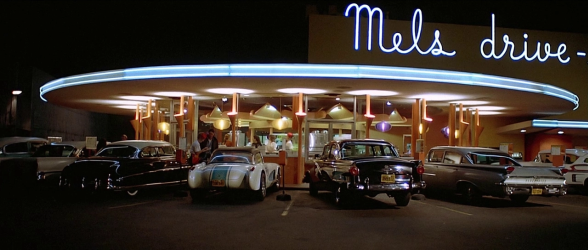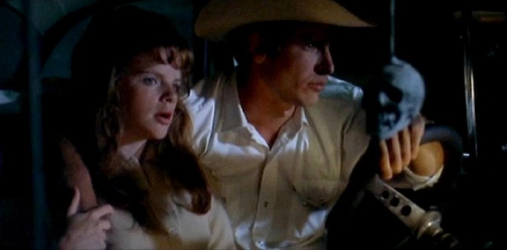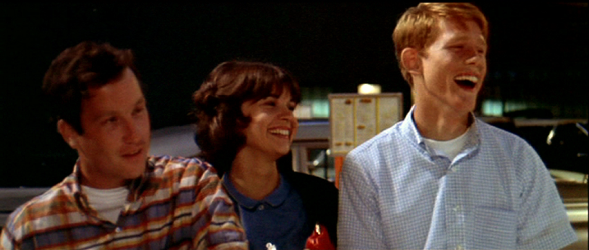For a variety of reasons which I shan’t belabor (or rather, belabor even more than I already have, which is a lot), many of the Baby Boomers’ cultural artifacts leave me cold, often not because they’re bad per se but because they’re wildly overrated. Forest Gump, for example, made its way to Oscar success by name-dropping a bunch of tired old cultural references. The Graduate, while beautifully made, seemed pretty pointless to me, and the less said about Hair, the better.
I didn’t get the big deal about American Graffiti when it came out, either, but I was really, really young to appreciate a movie about shiftless teens driving around a small town in the last days of their summer before college. It wasn’t until I watched it this time that I realized it was basically a Boomer artifact. (My dad and members of his cohort used to bitch because they had done all that stuff first, five years earlier.)

There was a time when one car looked different from another.
The now iconic ending, where the fates of the characters are revealed in little capsules under their pictures, seems almost comically pointless today. The kids were sort of puzzled by it, like, “this wasn’t based on real people, was it?” And it also stands out, today, that Lucas nixed Huyck and Katz’s suggestion to provide fates for the female characters. Like, Steve (Ronny Howard) stays behind in Modesto to be with Laurie (Cindy Williams), presumably—this is kind of Steve’s character arc, and the bio tells us 0nly that he stays behind and starts an insurance business (or something). Not a peep about the marriage that presumably kept him there.
Animal House did it better. Yes, it’s a parody of this movie. Even so, it’s not just funny, it somehow manages to imbue the characters with genuine life after the movie. Graffiti turns them into disappointments, somehow.
But this is a relatively minor point. Of the seven films George Lucas directed, this is probably the best. It’s interesting to note that the problems that plague virtually all his other films (primarily wooden acting, clunky dialog and groan-worthy plotting) are missing here. I assume the lack of clunky dialog came from him drawing on actual experience, which in turn helps the acting. The actors, given characters they can identify and dialog they can say (Harrison Ford famously observed on the set of “Star Wars”, “you can type this shit but you can’t say it”) turn in endearing performances.

I think that’s the late Debralee Scott, who would be a semi-regular on “Welcome back, Kotter”.
And there is no plot.
Basically, Steve and his pals Curt (Richard Dreyfuss), Terry (Martin Cruz Smith) and John (Paul LeMat) are driving around Modesto one night having a variety of adventures. Steve is splitting up with longtime steady girl Laurie because college girls are easy, and he’s going to college. Curt is getting cold feet about going to college with Steve. Terry is enjoying a brief moment of borrowed awesomeness as he drives around in Steve’s car. And John’s game is getting cramped when a bunch of cute girls foist a very cute, but very young little sister, Carol (Mackenzie Phillips, looking adorable).
Curt catches a brief glimpse of a dream girl (Suzanne Somers, in a now-famous cameo), whom he chases around, ultimately alighting on a plan to contact her through the local DJ, Wolfman Jack (as himself), in what could be the movie’s most allegorical segment. There’s an odd feel to the whole thing, like it’s a metaphor for chasing something that’s unattainable but still worth chasing. On the other hand, it’s probably just something that happened to George. (All four of the main characters are said to be Lucas at different points in his not quite 30 year life.)

In homage to which, all of the actors are in their 30s.
This gets kind of fascinating when you consider Terry’s idol worship of John. See, John is a legendary drag racer (who’s being pursued by a reckless Harrison Ford) and he’s getting the idea that it’s time to hang up his fuzzy dice but Terry tells him he can go on forever, and he’s the best, and all that. It’s probably best not to overthink it.
I’m not sure but I think Harrison Ford’s girl when he first shows up is the late Debralee Scott, but then switches to a different girl the next time he shows up, before he finally winds up with Laurie. There’s a lot of little details in the movie, and a lot of time to notice them. It’s got a very casual pace. It feels all of it’s near two hour running time, but not in a bad way.
It is a lot like hanging out with a bunch of school chums.
We all rather liked it. Great cars. Gorgeous, gorgeous cars, really. Great music. The Flower and I knew almost every tune played. She, of course, is a big Beach Boys fan, and likes that music generally, which boosted the whole movie for her. I have a peculiar fondness for movies that take place over the course of one night, so I found it appealing in the regard. But The Boy, who has no especial affinity for the music, the automobiles or the time period also really enjoyed the movie.
So that’s a good indication it really is a good movie, beyond any value as a nostalgic relic.

Never did get Suzanne Somers’ appeal, though.
